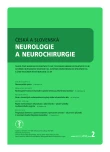Intraluminal Shunt in Carotid Endarterectomies Increases the Risk of Ischemic Stroke
Authors:
M. Orlický 1,2; P. Vachata 1,2; R. Bartoš 1,2; M. Sameš 1
Authors‘ workplace:
Neurochirurgická klinika Masarykovy nemocnice a Univerzity J. E. Purkyně, Ústí nad Labem
1; ICRC – Mezinárodní centrum klinického výzkumu, FN u sv. Anny v Brně
2
Published in:
Cesk Slov Neurol N 2015; 78/111(2): 163-166
Category:
Original Paper
doi:
https://doi.org/10.14735/amcsnn2015163
Overview
Aim:
A large prospective study compared the incidence of new ischemic lesions of brain parenchyma during carotid endarterectomies (CEA) with or without usage of an intraluminal shunt. Magnetic resonance imaging of the brain parenchyma (diffuse weighted mode, MR DW) was used to show lesions.
Groups and methods:
1,019 CEA were performed during a prospective study from 2005 to 2013 at the Neurosurgery Clinic, Masaryk Hospital in Usti nad Labem. All procedures were done under regional anaesthesia with selective carotid artery shunting according to the neurological status after carotid artery branches clamping. Magnetic resonance evaluation of the brain parenchyma in diffuse weighed mode (MR DW) was performed at admission to the hospital and 24 hours after the surgical procedure. Acute new MR DW lesions were evaluated according to the classification published by Szabo et al. (Stroke 2001).
Results:
Serious complications (stroke, myocardial infarction, death) occurred in 3.2% of symptomatic and 1.7% of asymptomatic patients. An intraluminal shunt had to be used in 73 out of 1,019 patients (7.1%). New ischemic lesion was detected in 78 patients (7.7%). Majority of these lesions were neurologically asymptomatic (80%). New ischemic lesion on MR DW was detected in 25 (34.3%) shunted patients and in 53 (5.6%) non‑shunted patients. Aetiology of the majority of these lesions involved embolization or hypoperfusion.
Conclusion:
The use of an intraluminal shunt during carotid endarterectomies increased the incidence of new ischemic lesions almost seven‑ fold. These results support our strategy to use intraluminal shunts selectively.
Key words:
carotid endarterectomy – carotid artery shunting – stroke
The authors declare they have no potential conflicts of interest concerning drugs, products, or services used in the study.
The Editorial Board declares that the manuscript met the ICMJE “uniform requirements” for biomedical papers.
Sources
1. Arazi HC, Capparelli FJ, Linetzky B. Carotid endarterectomy in asymptomatic carotid stenosis: a decision analysis. Clin Neurol Neurosurg 2008; 110(5): 472– 479. doi: 10.1016/ j.clineuro.2008.02.012.
2. Rothwell PM, Goldstein LB. Carotid endarterectomy for asymptomatic carotid stenosis asymptomatic carotid surgery trial. Stroke 2004; 35(10): 2425– 2427.
3. Endarterectomy for asymptomatic carotid artery stenosis. Executive committee for the asymptomatic carotid atherosclerosis study. JAMA 1995; 273(18): 1421– 1428.
4. Randomised trial of endarterectomy for recently symptomatic carotid stenosis: final results of the MRC European Carotid Surgery Trial (ECST). Lancet 1998; 351(9113): 1379– 1387.
5. Ferguson GG, Eliasziw M, Barr HW, Clagett GP, Barnes RW,Wallace MC et al. The North American Symptomatic Carotid Endarterectomy Trial: surgical results in 1,415 patients. Stroke 1999; 30(9): 1751– 1758.
6. Gumerlock MK, Neuwelt EA. Carotid endarterectomy: to shunt or not to shunt. Stroke 1988; 19(12): 1485– 1490.
7. Michaelides C, Nguyen TN, Chiappa KH. Cerebral embolism during elective carotid endarterectomy treated with tissue plasminogen activator: utility of intraoperative EEG monitoring. Clin Neurol Neurosurg 2010; 112(5): 446– 449. doi: 10.1016/ j.clineuro.2010.01.009.
8. Rerkasem K, Rothwell PM. Routine or selective carotid artery shunting for carotid endarterectomy (and different methods of monitoring in selective shunting). Cochrane Database Syst Rev 2009; 7(4): CD000190. doi: 10.1002/ 14651858.CD000190.pub2.
9. Cho J, Lee KK, Yun WS. Selective shunt during carotid endarterectomy using routine awake test with respect to a lower shunt rate. J Korean Surg Soc 2013; 84(4): 238– 244. doi: 10.4174/ jkss.2013.84.4.238.
10. Rerkasem K, Rothwell PM. Routine or selective carotid artery shunting for carotid endarterectomy and different methods of monitoring in selective shunting. Stroke 2010; 41: 53– 54.
11. Evans WE, Hayes JP, Waltke EA. Optimal cerebral monitoring during carotid endarterectomy: neurologic response under local anesthesia. Journal of Vascular Surgery 1985; 2: 775– 777.
12. Cao P, Giordano G, Zannetti S, De Rango P, Maghini M,Parente B et al. Transcranial Doppler monitoring during carotid endarterectomy: is it appropriate for selecting patients in need of a shunt? J Vasc Surg 1997; 26(6): 973– 980.
13. Ali AM, Green D, Zayed H. Cerebral monitoring in patients undergoing carotid endarterectomy using a triple assessment technique. Interact CardioVasc Thorac Surg 2011; 12(3): 454– 457. doi: 10.1510/ icvts.2010.235598.
14. Ricotta JJ, Charlton MH, DeWeese JA. Determining criteria for shunt placement during carotid endarterectomy. EEG versus back pressure. Ann Surg 1983; 198(5): 642– 645.
15. Szabo K, Kern R, Gass A, Hirsch J, Hennerici M. Acute stroke patterns in patients with internal carotid artery disease: a diffusion‑ weighted magnetic resonance imaging study. Stroke 2001; 32(6): 1323– 1329.
16. DeBakey ME. Successful carotid endarterectomy for cerebrovascular insufficiency. Nineteen-year follow-up. JAMA 1975; 2233(10): 1083–1085.
17. Bonati LH, Jongen LM, Haller S, Flach HZ, Dobson J,Nedorkoorn PJ et al. New ischaemic brain lesions on MRI after stenting or endarterectomy for symptomatic carotid stenosis: a substudy of the International Carotid Stenting Study (ICSS). Lancet Neurol 2010; 9: 353– 362. doi: 10.1016/ S1474‑ 4422(10)70057‑ 0.
Labels
Paediatric neurology Neurosurgery NeurologyArticle was published in
Czech and Slovak Neurology and Neurosurgery

2015 Issue 2
- Metamizole vs. Tramadol in Postoperative Analgesia
- Memantine in Dementia Therapy – Current Findings and Possible Future Applications
- Memantine Eases Daily Life for Patients and Caregivers
- Metamizole at a Glance and in Practice – Effective Non-Opioid Analgesic for All Ages
- Advances in the Treatment of Myasthenia Gravis on the Horizon
Most read in this issue
- Aggressive Vertebral Hemangioma
- Neuromyelitis Optica
- Congenital Central Hypoventilation Syndrome (Ondine‘s Curse)
- Radiologic Assessment of Lumbar Spinal Stenosis and its Clinical Correlation
